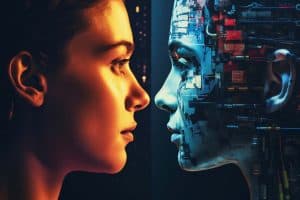Is this an article for coaches or for businesses that hire coaches? Or is it for “Change Management”, and how can that change be driven? We think it is an eye-opener for all four. It is long, as it is research and not an “opinion.” At the end of this research, we have a list of resources for further reading.
You cannot deny (unless you live on a different planet) that artificial intelligence (AI) is increasingly transforming how organizations (of any size) develop their people. From leadership coaching to team dynamics, AI tools offer new ways to personalize learning and scale coaching across an organization.
In 2025, AI has firmly “stormed into every corner of business, and corporate training is no exception”. This report presents how AI is augmenting coaching practices to support team development and organizational growth, focusing on medium-sized and family-owned businesses and bigger ones—the scale changes, but not the essence of the capabilities.
We will explore 2025 trends, future outlooks for the next decade, real-world use cases, impact metrics, ethical considerations, and implementation challenges.
The goal is to provide HR professionals and organizational leaders with a comprehensive view of AI’s role in modern coaching.
Table of Contents
ToggleHeads up: Our Take
Having the experience and combined skills of an IT/Tech background, along with business development and coaching, we concluded (using all available data) that AI can be a supplementary tool for organizations regarding coaching needs (leadership or teams), but with an interesting twist. AI is nothing without “learning.”
So, organizations that understand the investment in knowledge can train their AI tools with information (from the market and in-house) to get the best help from AI. As with AI prompts, the best description/instruction produces the best results, which is the case with this case.
Feed the system with garbage and get garbage. In coding, where Systems Analysis is my primary degree, we call it GiGo (Garbage In, Garbage Out). AI has the potential to filter information better, but the organization needs to be better structured. It is applicable indeed.
The whole thing is not new. We did it when developing “Intranets” for organizations, if you remember the lingo. The entire case back then was not just to store information in a structured way, but to build code and processes that retrieve that information and use it in a practical, useful, real way that helps to decide business matters. The same is true with AI.
The organization must eliminate resistance to change (fears) and see change as an opportunity.
It is not by chance that the “Fear of Change” is one of the primary fears (as also described in my book Fear, This Liar). Of course, coaches themselves (including myself) can raise the same resistance to change when they don’t see the opportunity.
Read this research, as it addresses many aspects of adopting AI for coaching and development.
Current Trends in 2025: AI-Powered Coaching in Practice
AI is already used to enhance leadership and team coaching in several notable ways.
Personalized virtual coaching and learning
Over half of L&D professionals (58%) believe AI enhances leadership training by enabling adaptive learning content and 24/7 virtual coaching support. AI-driven platforms can tailor coaching content to individual needs, providing “hyper-personalized learning” that evolves with each learner.
For example, modern AI coaching assistants (often chatbots or digital coaches) can offer on-demand guidance, answer managers’ questions, or even help employees “role-play difficult conversations” in a risk-free environment.
This on-demand, always-available support means coaching is no longer confined to occasional in-person sessions – it can occur anytime, reinforcing development continually.
Real-time feedback and team insights
A new generation of AI “experience agents” monitors day-to-day team interactions and provides timely, context-aware nudges to managers and employees.
Unlike static training, these intelligent agents analyze communication patterns, calendar data, engagement survey results, and more to spot coaching opportunities in the flow of work.
They might remind a manager to recognize a team member or alert leaders to a drop in team morale. Such tools fill the “in-between moments” between formal coaching check-ins with personalized feedback, helping keep development goals in mind.
Importantly, they do this without replacing the human coach—the AI provides frequent micro-coaching while the human element remains central to deep, trust-building conversations.
Hybrid human-AI coaching models
So, in 2025, organizations are adopting a blended approach where AI complements human coaches. AI excels at scalability and data-driven insights, while people provide the empathy and cultural nuance AI still lacks.
Many companies view AI as a “copilot” to human coaches or managers, not a substitute. For example, a company launched an AI coach that delivers customized employee support but can hand it off to human coaches when deeper discussion is needed.
In an early rollout, 51% of employees said they prefer a mix of AI and human coaching (only 15% preferred AI alone). This reflects a broader trend: AI handles routine coaching guidance or analyzes data at scale, while human experts intervene for complex, emotional, or high-stakes coaching topics.
The result is a more scalable coaching model that can reach more employees across a medium-sized business while maintaining a human touch for relationship-building.
Adoption and momentum
Even traditionally resource-constrained organizations are beginning to experiment with AI coaching. By early 2025, at least 11 companies (including large firms like Unilever) had piloted a specific AI coaching system, with another 50 companies planning to adopt it soon.
Corporate surveys show about 70% of L&D professionals view AI in leadership development as a step forward, although 59% believe AI still struggles with cultural nuances and emotional intelligence in coaching.
The current trend is cautious optimism: Businesses embrace AI to support leadership and team development, enjoying benefits like personalization and scalability while being aware of its limitations.
Future Outlook: AI Coaching in the Next 5–10 Years
AI’s role in coaching is poised to grow significantly over the next decade.
Ubiquitous “AI coaches” for every leader
We can expect AI coaching tools to become a standard part of leadership development programs, even in mid-sized and family-run companies. Just as a Financial software firm rolled out an “AI coach in every leader’s pocket” in 2025, the coming years may see many organizations giving each manager access to a personal AI coaching assistant.
These AI coaches will likely integrate seamlessly into daily work tools.
Developers are expanding AI assistants to proactively appear within platforms like Slack, or other workflow apps “exactly when needed”.
By 5–10 years from now, a manager might receive a gentle AI prompt during a tense team discussion or a real-time suggestion on how to frame feedback – all within the apps they’re already using.
Advances in AI capabilities
Future AI coaching agents will be far more sophisticated in understanding context, emotion, and nuance. Today’s AI sometimes struggles with cultural context or the emotional subtleties of leadership coaching.
In the coming years, advances in natural language processing and emotion AI promise more empathic and context-aware coaches. We may see AI that can reliably detect team sentiment (through analysis of language, tone, and even video cues) and adjust its coaching advice accordingly.
There is active research on making AI more adept at “emotional intelligence,” which is critical for coaching on soft skills.
While a human touch will still be essential, the gap may narrow as AI learns to better “grasp cultural nuance” and handle sensitive coaching topics appropriately.
Integrated, immersive development experiences
AI-driven coaching will likely merge with other emerging technologies to create richer development experiences. For example, by 2030, immersive coaching simulations could be imagined where generative AI combined with virtual or augmented reality allows leaders to practice difficult conversations or crisis scenarios in a lifelike way.
Early steps in this direction are already visible – one AI coach platform added a feature for managers to role-play high-stakes conversations with the AI, which provided empathetic, context-rich responses.
In five years, such role-play simulations could be commonplace and even more realistic, giving leaders a safe sandbox to hone their skills.
AI might also leverage big data to forecast team dynamics and suggest preventive coaching (for instance, predicting which teams might benefit from intervention or which high-potential employee needs new challenges to stay engaged).
Wider adoption and democratization
Over the next decade, the use of AI in coaching will likely trickle down from large enterprises to medium-sized companies and even small family businesses. It already is, but there is a lack of structure in small family businesses, where, if AI is adopted, it can cause more issues than solutions.
As AI tools become more affordable and user-friendly, organizations with limited HR budgets can implement AI coaching at scale without hiring large teams of trainers.
The rising generation of leaders is also more AI-native. Next-gen leaders are far more optimistic about adopting generative AI in family enterprises than incumbent leaders.
This generational shift means that in 5–10 years, many family-owned businesses will have leadership comfortable with AI coaches and analytics, driving a cultural change in how coaching is delivered.
We may see family firms using AI to bridge leadership transitions, with AI providing continuity and knowledge transfer as one generation mentors the next.
By 2030, AI-enabled coaching is expected to be mainstream – a regular part of leadership and team development, with human coaches and AI working in tandem.
The best leaders will use AI as an intelligent co-pilot to enhance their decision-making and people skills, while “never flying solo” without human insight.
As one expert put it, the future is about using AI to “enhance awareness and accountability while allowing leaders to show up with empathy and presence”, so that AI makes managers better humans, not less human.
Use Cases and Case Studies of AI Coaching
Real-world examples illustrate how AI-driven coaching is successfully implemented across different organizations, providing lessons that can be applied to medium-sized and family-run businesses.
Experian’s “Coach in Your Pocket” for Managers
Experian, a global financial services firm, launched an AI-first leadership development program to support its mid-level managers. To supplement Experian’s strong coaching culture, they piloted an AI coach (named “Nadia”) with a select group of managers.
The AI coach was available to managers for on-demand advice and practice, directly addressing two needs: scaling coaching beyond what limited human coaches could cover, and providing support “in the flow of work” rather than just at quarterly trainings.
The pilot saw extraordinary adoption – within one hour of launch, 100% of the invited managers engaged with the tool. Managers found it immediately helpful, giving the pilot a Net Promoter Score of 85 (which later rose to 96 in an expanded beta).
Plus, 100% of participants said they would continue using the AI coach as we advance.
This case demonstrates that with the proper rollout and user education, even security-conscious organizations can achieve near-universal uptake of AI coaching. Experian also discovered new uses for the AI: managers began using Nadia to role-play challenging conversations and get instant feedback, which helped build their confidence and skills in a safe environment. The success of this pilot led Experian to integrate AI coaching into its global leadership development efforts.
Mid-Sized Tech Firm – Engagement Boost through AI Analytics
Not only large enterprises see benefits. A mid-sized technology firm implemented IBM’s Watson Talent AI platform to enhance employee development and feedback processes.
The AI analyzed real-time data on employee performance and sentiment to personalize coaching and recognition. Within six months of integrating these AI tools, the company reported a 30% increase in employee engagement scores.
Managers could identify previously overlooked issues – for example, areas where employees felt underappreciated – and take action guided by the AI’s insights. This led to improved job satisfaction and is credited with boosting retention.
This case shows that medium-sized companies can leverage AI to augment their HR teams. By crunching engagement data and suggesting targeted interventions, AI effectively coached the managers on how to better support their teams.
Accenture – AI-Guided Talent Development
Global consultancy Accenture used AI in a slightly different coaching capacity – to match employees with projects aligned to their skills and career goals.
This AI-driven talent coaching approach ensured people were “in the right seats,” leading to higher fulfillment. The outcome was a 30% rise in employee retention over two years after introducing the AI matching system.
By helping employees grow in directions they valued, the AI functioned as a career coach at scale.
Similarly, Accenture applied AI to streamline performance feedback, reducing managers’ time spent on evaluations by 60% and freeing them to have more meaningful coaching conversations with their teams. These results underscore AI’s ability to improve efficiency and effectiveness in developing talent.
While many examples come from larger firms, the principles carry over. Family-owned enterprises are beginning to explore AI to support their next generation of leaders.
For instance, a family business with limited HR staff could use an AI coaching agent to regularly monitor employee engagement, alert the owners to team issues early, or provide on-demand leadership tips to new family managers.
The key takeaway from case studies is that AI can democratize coaching, making quality development advice available broadly, not just to the top executives.
Surveys indicate that those who “get it right” see AI as a catalyst for future success even without naming specific family firms. They are actively piloting such tools to prepare for succession and growth.
Metrics of Impact: Measuring AI-Driven Coaching Success
Organizations leveraging AI in coaching track key performance indicators (KPIs) to evaluate their impact on people and business outcomes.
Employee Retention Rates
Because coaching aims to improve job satisfaction and growth, one primary goal is reducing turnover. Many companies adopting AI coaching have seen notable improvements in retention.
For example, Accenture’s AI-driven development initiatives led to a 30% increase in retention over two years. AI coaching can boost loyalty and decrease the costs associated with replacing staff by ensuring employees feel supported in their growth.
Employee Engagement & Satisfaction
Engagement survey scores and employee feedback are critical indicators of a healthy team environment. AI coaching appears to improve engagement in several cases.
A mid-sized firm using AI reported a 30% jump in engagement scores within half a year. Similarly, IBM found that employees felt more valued when AI promptly addressed their feedback, resulting in a 20% increase in satisfaction scores.
User surveys are positive in terms of satisfaction with the coaching—95% of employees in one AI coach pilot expressed satisfaction with the experience. High engagement and positive sentiment suggest that AI-augmented coaching makes employees feel heard, supported, and more connected to their company’s development culture.
Performance and Productivity Metrics
Another impact area is employee and team performance. While “performance growth” can be hard to isolate, proxies like productivity or goal achievement are monitored.
According to Deloitte, companies utilizing AI in performance management have seen an average productivity increase of 30%. One reason is efficiency: AI can automate administrative burdens (scheduling coaching sessions, analyzing surveys, preparing reports), allowing managers to spend more time on high-value coaching conversations.
Accenture’s experience is telling. By using AI tools to cut 60% of the time managers spend on reviews, managers could engage more deeply with their teams, ultimately improving performance quality.
Some AI coaching platforms also track specific behavior changes (e.g., frequency of feedback conversations, goal completion rates) as direct performance indicators. Over time, improvements in these coaching-related behaviors are linked to better team output.
Leadership Development Outcomes
Organizations may track the progression of coached employees, for example, promotions, leadership pipeline strength, or skill acquisition, as a long-term metric.
While quantitative data here is still emerging, anecdotal evidence suggests AI-supported coaching accelerates learning.
In a platform’s AI coach pilot, 16% of employees already reported greater confidence at work, a proxy for leadership capability growth, after a short usage period.
Companies also monitor 360-degree feedback improvements for leaders who use AI coaching (e.g., higher leadership effectiveness scores).
As AI coaching programs mature, we expect to see more formal studies on how they influence promotion rates and competency development compared to traditional coaching.
ROI and Business Outcomes
Ultimately, the success of AI in coaching ties to business results, and some organizations calculate a return on investment. This can include reductions in turnover costs, gains in productivity, or even increased revenue from a more engaged workforce.
While specific ROI figures vary, Experian’s case highlighted the importance of a “clear, quantifiable ROI” before scaling up their AI coaching program company-wide.
HR leaders may combine multiple metrics (retention improvement, engagement uplift, etc.) to demonstrate that AI coaching drives tangible organizational growth. For instance, highly engaged workplaces are, on average, 21% more profitable, so an AI tool that lifts engagement can be linked to long-term bottom-line benefits.
In summary, organizations measure AI coaching success not just in usage stats, but in people metrics (like retention and engagement) and performance metrics (productivity, skill growth) that connect coaching efforts to organizational health.
Early data is encouraging, but maintaining rigorous tracking will be key to proving the sustained impact of AI-driven coaching.
Ethical Considerations: Balancing Tech and the Human Touch
Implementing AI in coaching raises critical ethical questions that organizations must navigate carefully. This may be reduced when a human coach is involved, as a coach is trained to leave their bias outside of the equation (or at least they must).
Bias and fairness
AI systems are only as good as the data and algorithms behind them.
If the underlying data set is biased (for example, past leadership evaluations favored a particular personality type or demographic), the AI’s coaching suggestions could inadvertently reinforce those biases. To exemplify this, 30% of L&D professionals worry that AI could reinforce bias in leadership development.
It is crucial to build ethical checks into AI coaching programs. As one expert succinctly advised, “Bias in data = bias in output,” so developers and HR leaders need to actively audit AI recommendations for fairness.
Ensuring diversity in training data, testing AI outputs for disparate impact, and maintaining a human oversight mechanism (a real coach or HR professional who can override or question AI advice) are emerging best practices to prevent discriminatory outcomes.
Privacy and data security
AI coaching often relies on sensitive employee data, such as performance reviews, communication patterns, or survey responses, which raises privacy concerns.
Employees may fear that “Big Brother” is watching if AI monitors their emails for coaching. It’s imperative to be transparent about what data is collected and how it will be used.
Employees should “understand why they’re being nudged, what data is being used and how it benefits them”.
Making AI coaching an opt-in program or communicating the boundaries (e.g., it’s there to help you grow, not to punish you) can build trust.
Data must be handled securely and in compliance with privacy laws—a lesson underscored by Experian’s pilot, which only moved forward after a close partnership with IT security to ensure all personal data was protected.
Family-owned businesses, often close-knit communities, need to be especially mindful of confidentiality; misuse of data in a family context can erode the high trust that typically exists.
Dehumanization and the coaching relationship
Coaching, at its heart, is a human-centric, trust-based activity.
A key ethical concern is whether introducing AI will depersonalize the coaching experience. Could relying on an algorithm for guidance make employees feel like “just a data point”?
Many experts emphasize that AI should not replace the human connection that makes coaching powerful. A fine line exists between helpful automated support and a cold, robotic interaction.
One safeguard is to design AI coaches with a conversational, encouraging tone and identify them as non-human agents so as not to mislead users. Preserving avenues for human interaction is equally essential.
For example, suppose an AI coach detects a serious emotional issue (say, an employee showing signs of burnout or distress). In that case, it should flag a human mentor or HR to step in, rather than attempting to handle deeply personal matters alone. This ethical design – keeping “humans in the loop” – ensures the “human touch” is never lost.
Companies are already addressing this in practice. As mentioned, a platform’s AI coach seamlessly hands off to human coaches when more in-depth support is required. Such hybrid models protect against the coaching relationship feeling too mechanistic.
Transparency and consent
Ethical AI coaching programs clearly state that an AI is involved and its capabilities. Hidden AI or undisclosed monitoring can breach trust. It’s advisable to obtain consent from participants before analyzing their data using AI.
Some organizations even involve employees in co-creating the guidelines for AI use (for instance, defining which types of feedback are appropriate for an AI to give vs. what should be escalated to a person). By providing employees agency and clarity, AI can feel like “a coach in your corner, not a robot in your inbox”.
In conclusion, the ethical deployment of AI in coaching hinges on augmenting, not undermining, the human element.
AI can be a positive force when handled with transparency, respect, and checks for bias. But used carelessly, it can “erode [engagement] fast.”
Organizations must, therefore, approach AI coaching with a strong ethical framework—one that prioritizes data privacy, fairness, and the dignity of the employee–coach relationship.
Implementation Challenges and Considerations
AI-driven coaching is challenging, especially for medium-sized and family-run businesses with limited resources or entrenched working methods.
Leaders considering these technologies should be aware of the common barriers to implementation and strategies to overcome them.
Resistance to Change and Cultural Hurdles
Introducing AI tools can meet skepticism or fear among staff and leadership.
Managers used to traditional coaching might be wary of algorithms advising them how to lead, and HR professionals may worry about their roles being displaced.
About a quarter of HR practitioners (24%) fear AI could lead to job displacement. There can be a generational split in family businesses – younger leaders are eager to try AI. At the same time, the older generation may be more cautious or “question the ability of their family business to capitalize on it”.
Overcoming this resistance requires change management: clear communication about how the AI will help (not replace) people, success stories to build buy-in, and perhaps gradual introduction (starting with a pilot program or voluntary participation). Experian’s approach was instructive: they created a GenAI Academy to let managers experiment with AI in a sandbox, which helped demystify the tools and build enthusiasm from the ground up.
Organizations can turn resistance into curiosity by allowing skeptics to play with the technology and see its benefits firsthand.
Cost and ROI Justification
Cutting-edge AI coaching solutions or data integration projects can be expensive. Medium-sized firms might hesitate at the price tag, unsure if the investment will pay off.
Building a solid business case is essential. This means identifying the pain points (e.g., high turnover, scarce coaching resources) and showing how AI can cost-effectively address them.
Sometimes, a phased implementation can help manage costs – for example, starting with an AI tool that addresses one specific need (such as an AI feedback survey tool) before expanding to a full coaching suite. It’s also worth noting that the cost of AI solutions is gradually decreasing, and cloud-based software-as-a-service models make them more accessible to smaller companies.
Still, leadership will want to see results. Tracking the KPIs discussed earlier (retention, engagement, etc.) and even doing a small controlled trial can provide data to justify a broader rollout.
In Experian’s case, demonstrating a “quantifiable ROI” from the pilot (via improved NPS, adoption, etc.) was key to getting approval to scale the AI coach further.
Data Infrastructure and Quality
AI coaching agents thrive on data, but not every organization has its people data in order. An AI can only provide intelligent coaching if it’s fed with relevant, high-quality information (such as performance metrics, engagement survey results, 360-degree feedback, communication patterns).
Many mid-sized and family businesses face challenges here: data may be siloed in different systems, or they may not regularly collect specific data. Incomplete or biased data will lead to flawed coaching feedback.
One implementation lesson is to get the data foundations right. This might involve investing in or upgrading an HRIS (Human Resource Information System) and ensuring it integrates with the AI tool.
It also involves cleaning existing data and establishing processes to update it continually.
One expert noted that “without real-time, role-specific and relational data, [AI coaching] agents risk becoming just another notification engine” with generic advice.
Companies should start by linking the AI into platforms employees already use (email, Slack, LMS, etc.) to gather contextual data, and ensure privacy and security on that data pipeline.
Initially, this infrastructure setup can be a hurdle, but the AI must deliver meaningful, customized coaching.
Skills Gaps and Training for Users
Deploying an AI coaching solution isn’t plug-and-play – HR teams and managers must know how to use it effectively.
A capability gap may exist if staff lack familiarity with AI or data analytics.
Organizations must be ready to invest in training and change management so that users understand the tool’s features and trust its recommendations. For example, if managers don’t know how the AI generates a coaching tip, they might ignore it.
Providing orientation sessions, Q&A support, and even “AI coaching playbooks” can help users integrate the tool into their daily routine. A positive user experience in the first weeks is critical to sustaining adoption.
Conversely, if the AI is too complicated or time-consuming, busy managers will abandon it.
Therefore, selecting user-friendly solutions and iterating based on feedback is part of overcoming this challenge. The earlier example of Experian’s pilot success (with 100% adoption in one hour) was partly because the interface was intuitive, and the company gave a brief demo to empower managers to explore it themselves.
Additionally, identifying internal “AI champions” – tech-savvy employees or younger next-gen family members – can create peer encouragement. Those champions can mentor others using the AI coach, easing the learning curve.
Integration with Existing Processes
Implementing AI coaching should not happen in a vacuum.
Aligning the new AI-driven practices with existing HR and coaching processes can be challenging. Questions arise: How does the AI coach’s feedback fit into our performance review cycle?
Will it conflict with our existing mentoring program? It’s essential to design the implementation so that AI enhances what’s already working. This might mean adjusting some workflows – for instance, incorporating AI-generated insights into monthly leadership team meetings, or using AI analysis in annual training needs assessments.
Family businesses might need to reconcile AI recommendations with their unique culture or values (perhaps configuring the AI with those values in mind).
Ensuring leadership endorsement and embedding the AI tool’s usage into official policy (like “managers are expected to check the AI dashboard weekly”) can help normalize it. Otherwise, the tool could languish on the sidelines of “how we do things here.”
In addressing these challenges, it’s helpful to remember that adoption is a journey.
Early setbacks or resistance are common, but with iterative improvement and responsive change management, organizations can reap the benefits of AI coaching.
Many companies start small – a pilot with one department – learn from the experience, and gradually expand the program.
With time and demonstrated success, even skeptics often come around, seeing AI as a helpful partner rather than a threat. As one HR leader advised regarding AI adoption, internal collaboration is key: “They’re enablers, not gatekeepers,” so bring IT, security, and stakeholders into the process early to smooth the path.
Overcoming these barriers allows an organization to unlock AI’s full potential, driving team development and fueling organizational growth.
Key Takeaways
Let’s sum all these up in a highlighted, easy-to-digest list.
AI in Coaching: Key Conclusions
Current Trends (2025)
- Personalized Coaching: AI delivers hyper-personalized and adaptive coaching, available 24/7.
- Real-time Feedback: AI tools monitor team interactions, providing timely, context-aware suggestions.
- Hybrid Models: AI is widely used as a complementary “co-pilot,” enhancing human coaches rather than replacing them.
- Cautious Optimism: AI adoption is growing, yet emotional and cultural nuance limitations remain.
Future Outlook (Next 5–10 Years)
- Mainstream Adoption: AI coaching will become standard in mid-sized and family-owned businesses.
- Enhanced AI Capabilities: AI coaches will better grasp emotional intelligence, context, and cultural nuances.
- Immersive Experiences: Integration with AR/VR will enable realistic, scenario-based coaching.
- Generational Shift: Younger, AI-native leaders will accelerate the adoption in family businesses.
Use Cases & Case Studies
- Scalability & Satisfaction: Early adopters report high satisfaction (95%) and increased employee confidence and engagement.
- AI “Coach in Pocket”: Immediate adoption when integrated naturally into workflows (e.g., Experian case).
- Engagement & Retention Boost: Proven increases in engagement scores (30%) and retention rates (up to 30%) among medium-sized firms.
- Democratization of Coaching: AI makes quality coaching accessible broadly, beyond senior leadership.
Metrics of Impact
- Retention Improvements: Turnover rates have been lower due to targeted coaching support.
- Engagement and Satisfaction: Significant uplifts in employee engagement and satisfaction.
- Performance Gains: Enhanced productivity and goal achievement, freeing managers to focus on meaningful coaching.
- Leadership Development: Accelerated skill growth, confidence, and leadership effectiveness.
- ROI: Tangible business outcomes justify investments in AI-driven coaching.
Ethical Considerations
- Bias & Fairness: Active measures required to prevent AI-driven bias from reinforcing inequalities.
- Data Privacy: Transparent communication and opt-in strategies are crucial for trust.
- Human Connection: Maintaining human oversight ensures coaching remains personal and empathetic.
- Transparency: Ethical AI implementation depends on clear communication about data use and AI roles.
Implementation Challenges
- Cultural Resistance: Gradual rollout, transparency, and demonstrations are crucial to overcoming skepticism.
- Cost Concerns: Demonstrating clear, measurable ROI can justify investments.
- Data Infrastructure: Essential to have robust and integrated data systems for effective AI coaching.
- User Skills Gap: Training and user-friendly AI interfaces are key to successful adoption.
- Process Integration: AI coaching must align seamlessly with existing HR processes to be effective.
Final Takeaway
- AI’s greatest strength lies in amplifying human potential, not replacing human coaches. Successful organizations will strategically integrate AI into their team and leadership development, balancing technology’s efficiency with human empathy and insight.
Research Resources
- Evans, P. & Khan, A. (2025). AI, Leadership, and Learning in 2025: Evolution or erosion of the human touch? Training Magazine.
- Business Insider (2025). AI-Powered Coach Is Helping Scale Workplace Learning.
- Barry, D. (2025). AI Experience Agents Are Reshaping Coaching, With a Human Touch. Reworked Magazine.
- Vorecol HR Blog (2023). The Impact of AI Tools on Employee Engagement and Wellbeing.
- Valence (2023). Experian Case Study: A Coach in Every Leader’s Pocket.
- Psico-Smart (2023). AI in Performance Management – Case Studies.
- PwC (2024). Global NextGen Survey 2024 – Family Business and AI.
- SHRM (2023). HR Adopts AI – Opportunities and Challenges.








